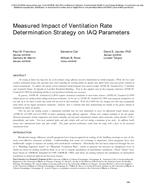Description
Air sealing of homes has long been one of the primary energy efficiency measures implemented by retrofit programs. While this has saved residents substantial energy costs, questions have arisen regarding the resulting indoor air quality since tighter homes may have greater retention of certain contaminants. To address this concern several residential retrofit programs have moved to adopt ASHRAE Standard 62.2, Ventilation and Acceptable Indoor Air Quality in Low-Rise Residential Buildings. Prior to this adoption most of these programs referenced ASHRAE Standard 62-1989 for determining whether or not mechanical ventilation was necessary. In general, ASHRAE Standard 62.2-2010 requires mechanical ventilation in most homes whereas ASHRAE Standard 62-1989 allowed greater air sealing without adding mechanical ventilation. In the case of ASHRAE Standard 62-1989, most programs attempted to air seal only up to the limit at which they would still not need to add ventilation. With 62.2-2010 this has changed such that only exceptionally leaky homes do not require mechanical ventilation. However, there is currently little data demonstrating the benefits of this greater amount of ventilation on indoor air quality. Over the past two heating seasons a randomized controlled trial has been undertaken to assess the differential benefit between using ASHRAE 62-1989 and 62.2-2010 in homes undergoing energy efficiency upgrades. Homes were assigned randomly to the two groups. Measured parameters include temperature and relative humidity and measured contaminants include carbon monoxide, carbon dioxide, VOCs, formaldehyde, and radon. Tests were conducted before and after retrofit, with each test lasting a minimum of one week. In addition, health surveys were administered before and after retrofit. This paper presents preliminary results from the study, with a focus on the measuredcontaminant levels.
Citation: IAQ Conference: IAQ 2013: Environmental Health in Low Energy Buildings
Product Details
- Published:
- 2013
- Number of Pages:
- 5
- File Size:
- 1 file , 990 KB
- Product Code(s):
- D-2013IAQConf-70




